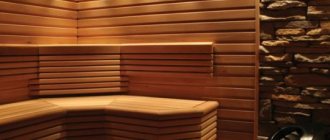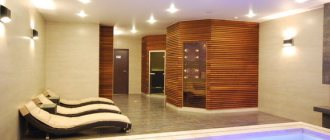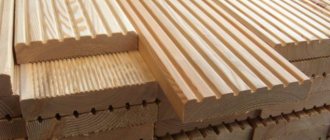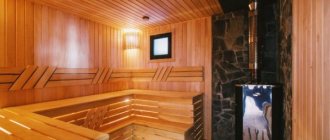Is processing necessary?
The opinions of bathhouse owners regarding the treatment of shelves with oil are radically opposite. Opponents of this measure argue that wood does not need additional protection, and it is better for it to remain natural and, therefore, safe for health. At the same time, they put up with the fact that the tree very quickly becomes covered with dirt and darkens.
This position is generally correct. Indeed, some wood treatment compounds cannot be used in a bathhouse, as they emit harmful substances. The consequences of such processing can be negative.
Prolonged skin contact with poor-quality impregnation causes irritation and inflammation, and vapors released from wood can lead to respiratory problems or allergic reactions.
But adherents of treatments believe that the main task is to choose the right protective agent. Without impregnation with protective compounds, the wood quickly begins to turn black, and pathogenic microorganisms multiply in it. The shelf is starting to deteriorate and will soon need to be replaced.
The conclusion is obvious. If you want your shelves to serve you for many years and not lose their beautiful appearance, you should definitely treat the wood with high-quality safe products.
For your information! A characteristic feature of the oil-wax coating is a slight weakening of the natural aroma of wood. In oak, the natural odor is reduced imperceptibly; in the case of alder and linden, a pronounced effect of weakening the characteristic spicy aroma is observed.
Subtleties of applying protective compounds
If you don’t know what to impregnate the walls in a bathhouse with, then this article will be relevant for you, because special impregnations for a bathhouse are suitable for any wooden surface, but it is also worth remembering some subtleties:
- It is much easier to process an unassembled structure, so if you have such an opportunity, saturate the elements of the bathhouse before assembling them;
- Protective products can have a negative effect on the skin, so to avoid this nuisance, you may not treat the side of the shelf in contact with humans. You can process the rest of the wood in the bathhouse without fear for your health, because only the shelves can affect the skin;
- Carry out work in the summer to make it easier to dry the steam room;
- It takes at least 4 days to completely dry the varnish and impregnations, after which you can relax in your bathhouse;
- Under no circumstances use highly toxic products, such as stains, because they negatively affect your health not only through the skin, but also through the respiratory tract;
Do not skimp on protective solutions, because your health and longevity of wood structures depend on their quality.
Criterias of choice
Oil is a traditional bath treatment product.
In former times, the wood in the steam room was covered with expensive oils of anise, rose, and lavender. They not only protected various log elements from moisture and rot, but also filled the room with a special natural aroma. Inexpensive hemp and linseed oils and wax were also used for processing. They have not lost their relevance today.
All existing oil compositions used in steam rooms can be divided into two large groups:
For treating walls and ceilings.
For impregnation of benches and other surfaces in direct contact with the skin.
General requirements for oils
Impregnation for a bath should provide reliable protection for the wood, and at the same time should not deprive it of its ability to breathe.
An important condition is the environmental friendliness of the oil composition.
Therefore, to cover the bath room you need to choose natural products. Synthetic impregnations contain chemical components that, when exposed to high temperatures, form harmful volatile compounds that are released into the atmosphere. In a small confined space, harmful substances are especially dangerous and can cause serious poisoning.
For a bath, it is necessary to use moisture-resistant impregnations that are well absorbed into the wood structure, protecting it from moisture.
There are special requirements for shelf oil. Its surface is constantly in contact with the skin, and a poor-quality composition will cause rashes and irritation. It should form a film on the wood, which can cause burns. It is important to use products with special marks for shelves.
Design features
The most widely used shelves are those consisting of a seat and support posts. Racks (thick vertical beams) are installed across the entire width of the shelf and connected by jumpers. As a rule, there are only two racks.
The seat is made of thinner boards. They are nailed to the frame in such a way that there is a distance of at least 1 cm between them. To prevent water stagnation, the shelves should be made inclined. To do this, it is enough to maintain an angle of about 2°. The width and thickness of all nailed boards must be the same. The required strength of the structure being constructed can be ensured if the thickness of the board is four times its width.
The shelves must be 1.5 meters or more in length. The optimal length is 1.8 m, which is comfortable for people of average height. The width of the top and bottom may be different. For the top one, it should be at least 0.9 m. The bottom one can be made 0.6 m wide, but not less than 0.4 m. When determining the height at which the top flooring will be attached, you can adhere to the principle that there should be between it and the ceiling more than 1.2 m. Between the remaining tiers it is enough to maintain 0.5 - 0.7 m. The lower tier should be located no lower than 0.2 m from the floor.
Your vacation will be more comfortable if you provide additional elements, not just flooring. This can be a special footrest, which should be placed so that the feet are above head level. Two boards fastened at an angle are suitable for this. It can be made removable. to the begining
Review of popular and proven brands
The following brands of shelf oils have earned many positive reviews:
Tikkurila Supi Laudesuoya
The Finnish product contains oil and additives. It has a creamy consistency, transparent color, and practically no odor. The product will not change the natural color of the wood, but will make it deeper. The shade depends on the species, hardness and original color of the wood.
Teknos Sauna - nature
Also produced in Finland, but by a different company - Teknos. It is a colorless, viscous liquid (oil), odorless. Does not contain organic acids, water is used as a diluent.
Biofa
Colorless protective composition, the most expensive of all those considered. Produced by the German company Biofa. Contains natural beeswax, paraffin wax, carnauba wax, plant extracts and essential oil.
Neomid oil
Impregnation for wooden structures of baths and saunas in the product line from Neomid. It is colorless and odorless. Contains natural oil and components that prevent the formation and development of mold and rot. It repels water and dirt well, preventing darkening and cracking on the wood.
Flaxseed oil
100% natural product, free from foreign impurities. It is obtained by cold pressing flaxseeds. When applied, the oil forms a weather-resistant, breathable layer and compacts the wood. Drying time from 1 to 5 days.
Carnauba Orange Oil Wax
This is carnauba wax dissolved in a mixture of orange and linseed oil. The consistency is like parquet mastic. Has a subtle citrus scent. Apply with a hard brush or rag. Drying time is 5 hours, but complete polymerization requires several days.
The surface of the board should be sanded. Possible contamination from the treated surface is removed by wiping with a rag. Recommended for processing shelves and backrests. You can process wooden bath utensils.
Expert opinion
Lovkachev Boris Petrovich
Bath master who knows everything about steaming
Advice! A good result is obtained if you first treat the wood with hard oil, and after 48 hours apply carnauba wax mastic. Solid oil penetrates deeper into the wood and serves as a good “primer” for wax. A nice bonus is that the consumption of expensive wax is reduced.
DIY oil-wax composition
Not all bath lovers trust ready-made bath products. If you want to be sure of the naturalness of the product, prepare an oil-wax composition with your own hands from the following components:
Flaxseed or hemp oil – 6 parts.
Beeswax – 1 part.
Preparation and application steps:
- Heat the oil to a boil in a water bath, simmer for 20-30 minutes.
- Add crushed and melted beeswax into the container. Stir the mixture over low heat until smooth.
- Apply the composition to the selected surface with a cloth, rubbing until the product is completely absorbed.
- Leave for 2-3 hours to absorb.
- Apply a second coat.
- After 2-3 hours, rub any effusions that appear on the treated surface with a dry cloth.
Why is there impregnation in the bath?
Since wood is a natural and absolutely safe material, it is often used for interior decoration. But at the same time, it strongly absorbs moisture, as a result of which the surface becomes loose and is an excellent habitat for microorganisms, in particular fungi. Bacteria that have settled in wooden cladding through their vital activity provoke deterioration of the material and the collapse of the structure.
The market offers a fairly wide range of impregnations for saunas and baths, which are capable of creating a coating that protects the casing from the destructive effects of high humidity and temperature changes. In addition, they have excellent antiseptic properties. The undeniable advantage of such products is the ability to give the surface an attractive appearance, performing the function of a decorative finish.
Note! When choosing impregnation for baths and saunas, you should give preference to products that do not emit toxic substances.
Antiseptic impregnation for a bath allows you to extend the service life of the internal lining, preserve its appearance, and protect it from rotting and mold. These are unique products that do not form a film on the surface of the wood and do not prevent it from breathing.
How to apply oil to shelves
Any product is applied to a dry, clean surface. Old wood must first be sanded and dust free. The room should be well ventilated for several days after the last use. The bath is preheated to a temperature of 35 - 40 degrees.
Craftsmen recommend processing shelves in spring or autumn. It is on warm days at an air temperature of + 15 degrees that the product dries well and allows you to complete the process faster.
The oil is applied in a thin layer with a brush or roller. For liquid formulations, the spray method can be used. The manufacturer indicates the number of layers required on the packaging. As a rule, these are 2 - 3 layers with a break of 1 - 2 hours.
If pure oil (usually linseed) is used, it is heated to 50-60 degrees before processing. The impregnation consumption and the number of layers also depend on the porosity of the wood. Sometimes the processing volume can double.
Do not rush to use the treated shelf; give it at least a day to absorb. Longer is better, because the point of using polymerizing oils is to let them dry.
Sequence of work
At the first stage, a wooden frame is made, to which the seat boards will then be attached. To do this, you will need a beam with a cross-sectional size, for example, 50x70 mm. The height of the beam depends on the height of the ceilings in the steam room. With a height of 2.35 m, you can prepare beams with a height of 1.09 m. The number of racks will directly depend on the width of the wall near which the shelves are installed. With a wall width of 3 m, ten beams will be enough.
The beams near the longer wall are installed in pairs and fastened with two sections of beams with the same cross-sectional size. The length of the upper transverse beam can be made 0.69 m, the lower one, placed at a height of approximately 0.55 m from the floor, can be 1 m. We connect the lower beam with an additional vertical beam 0.55 m high. The lower shelf will rest on it. To attach the bars to the posts, you must use two strong self-tapping screws.
The frame for the part installed along the smaller side is made in almost the same way. However, the height of the racks is taken equal to the height of the additional rack (0.55 m). the racks are connected to each other by beams with the same cross-sectional size, but 0.4 m long.
After the frame is made, the flooring is attached. To do this, take boards whose length corresponds to the length of the wall along which the shelves will stand. If the walls of the bathhouse are planned to be covered with clapboard, it is worth providing an additional gap near the walls. The boards must be laid with a gap of 1 to 2 cm. It is preferable to use oak wedges as fasteners, providing special holes for them in the places where the elements are sewn together. It is better to avoid using all kinds of metal nails and screws, since there is a high probability that the heated metal will burn the skin during a visit to the steam room.
If you decide to use self-tapping screws to attach the decking, you need to make sure that their heads are “recessed” into the wood. In this case, the distance from the surface to the screw head must be at least 5 mm. This will reduce the likelihood of skin contact with heated metal while a person is in the steam room.
To prevent injuries while visiting the steam room, the distance between the upper and lower shelves should be covered with boards. However, you should not sew up the space between the floor and the bottom shelf. This will provide the necessary ventilation. The shelves will dry out faster, and cleaning the steam room will be much easier. After the work is completed, it is necessary to sand the boards, smoothing the corners. to the begining
FAQ
In my bathhouse, the shelves and handles turned black, most likely from dirt. How can I restore color?
Only sanding will help remove the blackness. If the dirt is deeply absorbed, after sanding, go over the wood with hydrogen peroxide, then saturate it with a special oil.
The shelves in the bathhouse are quickly turning black, and a neighbor advised us to treat it with SUPI SAUNASUOYA. Will this help keep it clean for a long time?
The protective composition SUPI SAUNASUOYA (TIKKURILA) has proven itself to be effective when treating walls and ceilings in a bathhouse. But it cannot be used for processing a shelf.
I coated the shelves with linseed oil, but at the first fire the pain appeared in my eyes. What to do?
Stinging in the eyes is a reaction to oil evaporation with increased sensitivity to odors. The oil will gradually polymerize and the sensation will go away. To speed up the process, heat the sauna several times at maximum temperature (of course, without your own presence).
The correct choice of oil for impregnating wood and adherence to the technology for its application will help maintain the cleanliness and impeccable quality of the shelves in your steam room.
Kinds
Protective impregnations for wooden surfaces are divided into groups depending on the main component in their composition, as well as on the properties and method of application. According to the form of release, antiseptics are:
- aerosol;
- gel;
- in the form of a solution.
All types of impregnations for baths and saunas have water-repellent properties. Modern impregnations for baths rarely have only one function; they can often be used as universal preparations that can also protect wooden surfaces from the negative effects of elevated temperatures, excessive humidity and from damage by pathogenic microorganisms and harmful insects.
Based on their composition, the products are divided into water-soluble and oil-based. You can purchase a combined product in the form of varnish and paint, which is characterized by the effect of moisture protection and prevention from microorganisms. Most impregnations have additional performance qualities in the form of fire resistance and dirt-repellent function.
To pour or not to pour
A familiar dilemma: how to treat the shelves in the bathhouse or not treat it at all? The bathhouse is a stronghold of all that is pure and natural; any treatment with an uncharacteristic substance will immediately upset the idyllic balance, but sometimes it is impossible to leave the elements of the steam room without treatment. What should I do? First, let’s determine what negative factors affect wood and what the consequences are:
- In a traditional bath, the wooden elements of the shelf are exposed to high - 60-70 degrees Celsius, and high - over 70 degrees Celsius, temperature and absolute humidity, which in a steam bath can reach 75-80%. In addition, during the cold season, these same shelves are subject to alternating temperature influences. All this is fraught with linear vibration of the wood mass, which clearly causes disruption and, over time, destruction of its structure.
- High humidity is a paradise for microflora, and the moderate temperature observed in a steam room during periods of inactivity in the bath provokes the active development of colonies of microorganisms. Ultimately, they also destroy the tree, just like temperature fluctuations, but they do it faster and more obviously.
- Wood, over time, even in relatively favorable conditions, changes its original color, it becomes darker, and the pattern fades, the texture becomes less pronounced. Where the body rests, the eyes should also rest pleasantly, so the visual state of the interior is an important factor in maintaining the overall favorable “tone” of the bathhouse.
- Finally, the most key and aesthetically unpleasant factor. In conditions of high temperature, a person sweats intensely, and this is a natural and obviously beneficial effect of a bath. But the sweat-fat secretion is intensively absorbed into the thickness of the wood and over time becomes a breeding ground for microorganisms and, as a result, an unpleasant odor in the room.
Important! The greatest experts in bathing practice, the Finns, followed two mutually exclusive paths. Either, remain completely committed to naturalness in all bath items and, therefore, replace the shelves once every 3 years, or treat them with a protective composition.
In principle, the idea with replaceable shelves is good, however, it requires a well-thought-out design of the lid so that replacement is not difficult and occurs quickly and efficiently and, naturally, consumables made from commercial wood of decent quality are always available both in availability and price.
If this option is not possible, then it remains to carry out comprehensive protection of the product.
What it is?
It is believed that the ideal material for bath shelves is linden. This is due to several reasons. The main ones include the pleasant aroma that the wood releases when heated, as well as a very small number of knots.
But linden has one significant drawback. She is sensitive to moisture. With prolonged contact with water, wood becomes unusable within several years. The linden begins to rot. Because of this, it has to be changed, which requires additional costs.
The way out of the situation is to impregnate the bath shelves with a special composition, the main purpose of which is to protect them from high humidity.
Impregnation also solves another important problem - it neutralizes pathogenic bacteria and fungal microorganisms that actively multiply on damp wood. This helps maintain the health of those who take a steam bath.
Today, industrial stores offer a huge number of impregnations for bath shelves for purchase. You can also make them yourself.
The better
Let us clarify that treatment, in our understanding, is a preventive measure to prevent the future appearance of rot, mold, blue stains, infestation with wood-boring beetles and similar misfortunes. Or medicinal if infection has occurred. There are also compositions to reduce the flammability of wood.
In the first two cases we are talking about antiseptics - substances that kill fungi (fungicides) and insects (insecticides). In the third case - about fire retardants, which slow down fire or make wood non-flammable.
Is it necessary to treat the lining in a bathhouse with these compounds? Optional. They are good for preventing infections, they will keep the sauna from burning out completely, but they have restrictions on their use in the steam room
It is also possible to pay attention to impregnated wood
What to use in the steam room
While we're talking about this, there are a couple of products that can be used in a steam room too. However, their effectiveness is very limited.
For example, if you treat the paneling in the steam room of a bathhouse with “Belizna” bleach or its analogues, you can quickly get rid of the blue stain - this is the name of the fungal infection of wood, with which wood is often sold, since it does not affect the strength, it only spoils the appearance of the lumber.
Fungal infection - blue
BY THE WAY! Why Whiteness? Because there are a number of different antiseptics for wood, which contain nothing but sodium hypochlorite, as in “Belizna”. Well, maybe the concentration is different and the price is different.
After use and achievement of the result, “Whiteness” is washed off and ventilated (!more about ventilation in the bathhouse in a separate material). You can use the bathhouse when you can no longer smell the smell.
As a close analogue of bleach, you can use hydrogen peroxide - also a strong oxidizing agent that does not allow fungi to live.
For mold, you can use boric acid or borax, but now boron compounds are considered toxic, and among the cumulative poisons, that is, those that accumulate and are not eliminated from the body. The only good thing is that the poison is weak, it takes a lot of it to get poisoned.
But it’s not worth living with mold either; you die from it faster than from boron. If it starts up, then it’s no longer a matter of whether it’s a steam room or not, we have to start fighting. Until you get rid of it, you can’t use the bathhouse.
However, this applies to all infections - the more serious they are, the more serious the remedies. It’s better to treat the lining in a bathhouse with a professional antiseptic that will combat your problem, and then wash everything, than to change the entire lining. But it’s better to change the entire paneling than to risk your life because of black mold. With wood-boring beetles, the same strategy - while it makes sense to fight - we fight, if there are too many of them - we burn the affected tree.
Treatment inside other bath rooms
In this case, there is only one difference from the steam room: in other rooms you can use prophylactic agents. That is, do not wait for a problem, but prevent its occurrence by poisoning the lives of pests in advance.
Since there is no steam room heat in other rooms, all these poisons will not evaporate and be inhaled by humans.
Therefore, you can safely use antiseptics and fire retardants, whichever you like. In the washroom you will want to use non-washable compounds, but look at the label: if it says that it is for the exterior and not the interior, then it is better not to. It's better to update from time to time.
IMPORTANT! Antiseptics can be found on sale not only in the form of separate formulations, but also in the form of primers, which precede the application of varnish, glaze or paint. If you are going to paint with something, choose the right primer and you will not need to separately use an antiseptic.
Optimal sizes
As mentioned above, the optimum depends on what type of bathhouse its owner prefers - Russian or Finnish.
The average data for each type of bath are as follows:
- in the sauna, the width and height should be comfortable for sitting - this is from 40 to 60 cm in seat width and 45-50 cm in height;
- In a Russian bath, shelves are needed for lying and sitting. The minimum width is 60 cm, and the height is somewhere around 70-75 cm, but it is better to determine it anatomically, as recommended above.
The length of the shelf is usually equal to the distance between the parallel walls, since it is usually made along one of the walls
On our website there is a more detailed analysis of the nuances associated with the size of bath shelves.











